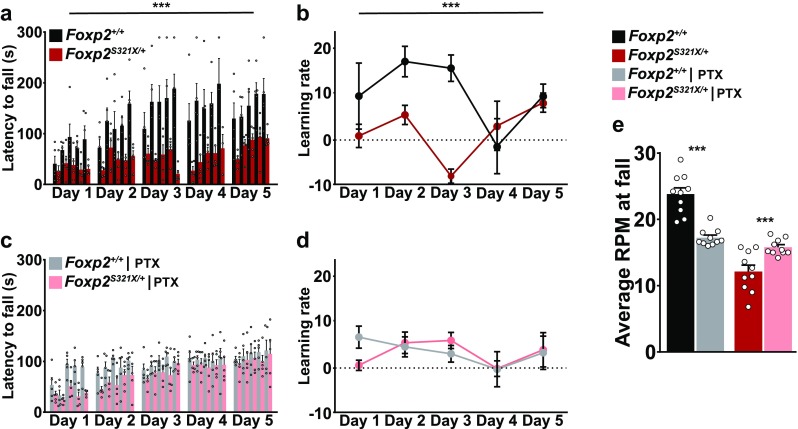Fig. 5.

Pharmacological blockade of inhibition modulates rotarod performance and motor skill learning. a Foxp2S321X/+ mice show impaired motor skill learning, shown by the decreased latency to fall (in seconds) across training sessions (days 1–5: Foxp2+/+ 75.3 ± 9.7, 120.4 ± 14.4, 164.7 ± 13.6, 165.5 ± 12.2, 160.7 ± 10.8. Foxp2S321X/+ 34.4 ± 3.1, 52.5 ± 7.4, 53.1 ± 8.7, 55.0 ± 8.15, 82.6 ± 8.38. P < 0.01, repeated measured ANOVA). Each session consists of five trials of 5 min, during which the rotarod accelerated from 4 to 40 rpm. b Both Foxp2+/+ and Foxp2S321X/+ mice show a positive learning rate during most sessions, with Foxp2+/+ mice having a significantly higher learning rate (days 1–5: Foxp2+/+, 10 ± 7.5, 17.8 ± 3.5, 16.3 ± 3.00, − 1.4 ± 6.3, 10 ± 2.7. Foxp2S321X/+, 0.9 ± 2.7, 5.7 ± 2.2, − 8.2 ± 1.6, 3.2 ± 5.6, 8.5 ± 2.2. P < 0.05, repeated measures ANOVA), learning rate was calculated as: . c, d Foxp2+/+ mice subjected to 0.1 mg/kg intraperitoneal injection of PTX show decreased rotarod performance and learning rates, whereas these were increased in Foxp2S321X/+ mice (latency to fall: days 1–5: Foxp2+/+ 71.7 ± 12.4, 91.7 ± 5.5, 96.4 ± 4.7, 104.4 ± 1.2, 114 ± 3.2. Foxp2S321X/+ 33.8 ± 4.5, 59.8 ± 5.7, 77.4 ± 5.3, 91.8 ± 1.1, 103.2 ± 3.61. NS learning rate: Foxp2+/+ 7.2 ± 2.5, 5 ± 2.3, 3.4 ± 1.9, − 0.1 ± 4.0, 3.6 ± 3.8. Foxp2S321X/+, 0.76 ± 1.2, 5.9 ± 2.5, 6.4 ± 1.9, 0.0 ± 1.8, 4.3 ± 3.9. NS, repeated measures ANOVA). e Average RPM at which mice fail the accelerating rotarod task during session 4 and 5 in vehicle and PTX conditions (vehicle, Foxp2+/+ 24.1 ± 0.94 RPM, Foxp2S321X/+ 12 ± 0.96 RPM, P < 0.001. PTX, Foxp2+/+ 16.7 ± 0.4 RPM, Foxp2S321X+ 15.3 ± 0.372 RPM, NS, two-sided Students’ T test). For all treatment conditions, N = 5 mice. ***P < 0.001
